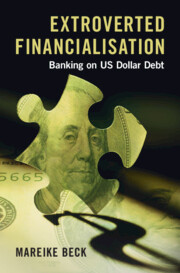Refine search
Actions for selected content:
26945 results in Economic history
9 - Conclusion
-
- Book:
- Extroverted Financialisation
- Published online:
- 07 August 2025
- Print publication:
- 21 August 2025, pp 162-174
-
- Chapter
- Export citation
2 - Extroverted Financialisation
-
- Book:
- Extroverted Financialisation
- Published online:
- 07 August 2025
- Print publication:
- 21 August 2025, pp 24-52
-
- Chapter
- Export citation
6 - Liability Management and the Transformation of Deutsche Bank
-
- Book:
- Extroverted Financialisation
- Published online:
- 07 August 2025
- Print publication:
- 21 August 2025, pp 105-126
-
- Chapter
- Export citation
Contents
-
- Book:
- Extroverted Financialisation
- Published online:
- 07 August 2025
- Print publication:
- 21 August 2025, pp xi-xiv
-
- Chapter
- Export citation
8 - Financialised Banking and Its Discontents
-
- Book:
- Extroverted Financialisation
- Published online:
- 07 August 2025
- Print publication:
- 21 August 2025, pp 143-161
-
- Chapter
- Export citation
Acknowledgements
-
- Book:
- Extroverted Financialisation
- Published online:
- 07 August 2025
- Print publication:
- 21 August 2025, pp xvii-xviii
-
- Chapter
- Export citation
7 - Commerzbank
-
- Book:
- Extroverted Financialisation
- Published online:
- 07 August 2025
- Print publication:
- 21 August 2025, pp 127-142
-
- Chapter
- Export citation
1 - Introduction
-
- Book:
- Extroverted Financialisation
- Published online:
- 07 August 2025
- Print publication:
- 21 August 2025, pp 1-23
-
- Chapter
- Export citation
Dedication
-
- Book:
- Extroverted Financialisation
- Published online:
- 07 August 2025
- Print publication:
- 21 August 2025, pp ix-ix
-
- Chapter
- Export citation
References
-
- Book:
- Extroverted Financialisation
- Published online:
- 07 August 2025
- Print publication:
- 21 August 2025, pp 175-194
-
- Chapter
- Export citation
Copyright page
-
- Book:
- Extroverted Financialisation
- Published online:
- 07 August 2025
- Print publication:
- 21 August 2025, pp viii-viii
-
- Chapter
- Export citation
5 - Grounding USDs
-
- Book:
- Extroverted Financialisation
- Published online:
- 07 August 2025
- Print publication:
- 21 August 2025, pp 91-104
-
- Chapter
- Export citation
3 - The Pfandbrief
-
- Book:
- Extroverted Financialisation
- Published online:
- 07 August 2025
- Print publication:
- 21 August 2025, pp 53-68
-
- Chapter
- Export citation
4 - The Eurodollar Roots of the German Model
-
- Book:
- Extroverted Financialisation
- Published online:
- 07 August 2025
- Print publication:
- 21 August 2025, pp 69-90
-
- Chapter
- Export citation
Figures
-
- Book:
- Extroverted Financialisation
- Published online:
- 07 August 2025
- Print publication:
- 21 August 2025, pp xv-xvi
-
- Chapter
- Export citation
Index
-
- Book:
- Extroverted Financialisation
- Published online:
- 07 August 2025
- Print publication:
- 21 August 2025, pp 195-199
-
- Chapter
- Export citation
The mechanics of finance private Genoese enterprises and market functions in Seville, 1460–1530
-
- Journal:
- Financial History Review , First View
- Published online by Cambridge University Press:
- 15 August 2025, pp. 1-27
-
- Article
-
- You have access
- Open access
- HTML
- Export citation
Class-based taxation: the fiscal paternalism of the Chilean income tax?
-
- Journal:
- Revista de Historia Economica - Journal of Iberian and Latin American Economic History / Volume 43 / Issue 2 / September 2025
- Published online by Cambridge University Press:
- 11 August 2025, pp. 191-216
- Print publication:
- September 2025
-
- Article
-
- You have access
- Open access
- HTML
- Export citation

Extroverted Financialisation
- Banking on US Dollar Debt
-
- Published online:
- 07 August 2025
- Print publication:
- 21 August 2025
Macroeconomic populism in Chile: Allende and the recession of 1973
-
- Journal:
- Revista de Historia Economica - Journal of Iberian and Latin American Economic History / Volume 43 / Issue 2 / September 2025
- Published online by Cambridge University Press:
- 06 August 2025, pp. 309-332
- Print publication:
- September 2025
-
- Article
- Export citation
